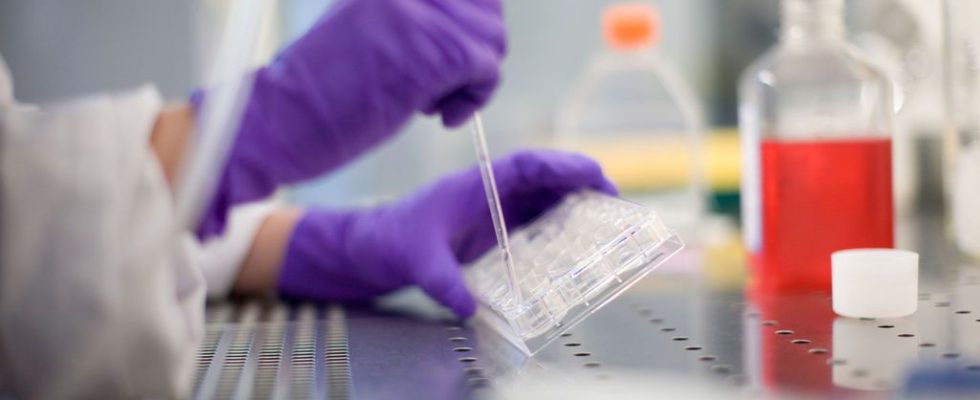A simple blood test to determine your risk of developing Alzheimer’s disease. He’s awake ? You will then be offered preventive measures, with medication and lifestyle changes (physical activity, cognitive stimulation, etc.). Here, according to Professor Bruno Dubois, is how, tomorrow, we will overcome this formidable pathology: by preventing its appearance.
The starting point for the thinking of this great Alzheimer’s specialist: the benefit, real but weak, of the drugs that should soon arrive on the market. “They will be offered at the early stages of the disease. But if they could be administered even earlier, even before the appearance of the slightest symptoms, they would probably prove to be much more effective”, hopes the former head of the dementia department. and behavioral studies at the Pitié-Salpêtrière hospital (AP-HP). It is still necessary to be able to identify people with such a high risk of falling ill that it would be justified to expose them to the undesirable effects, rare but sometimes very serious, of these products.
Impossible in the current state of knowledge. For several years, doctors have been able to identify the characteristic lesions of Alzheimer’s, the amyloid protein plaques that accumulate in the brain. But this is not enough, because individuals can be carriers, and never report the slightest symptom. For what ? Mystery. “Other factors must be at play. Perhaps in genetics, in the biological particularities of the patients, in their lifestyle, or in a combination of all of this. But today, we don’t know anything about it”, details Professor Dubois.
Biomarkers and artificial intelligence
To go further, this scientist relies on artificial intelligence algorithms. “From the analysis of the biological parameters of an individual, they will be able to tell us a level of risk”, he explains. Every neurologist’s dream. For it to become reality, this doctor has imagined a new kind of research center, which will carry out extensive investigations on volunteer patients. “We will make them pass as many tests as possible: blood samples, cerebrospinal fluid analyses, neuroimaging, genetic studies… Their data will feed gigantic databases from which scientific data will build these algorithms”, he explains. This new organization, Cermad (center of excellence and research on Alzheimer’s disease and degenerative diseases), will see the light of day in 2025 at the heart of the vast La Pitié-Salpêtrière hospital in Paris.
“We needed a structure situated between fundamental research, such as that carried out at the nearby Brain and Spinal Cord Institute, and clinical research carried out in hospital departments”, explains Professor Dubois. Experiments carried out in the laboratory, on animals or cells, have so far not made it possible to understand the sequence of biological processes leading to the disease. It is therefore necessary to seek information from the patients themselves, believes the specialist. “But in hospital departments, doctors and nurses have neither the time nor the means to carry out these examinations on patients on a large scale and to rigorously feed the databases that we need”, he notes. .
A virtuous model
Based on this work, the researcher also hopes to improve existing biomarkers. To identify the main lesions involved in the disease, doctors now use the analysis of cerebrospinal fluid. A complex exam. The ideal, of course, would be to detect these lesions in the blood. “We know that they leave traces there, but these are of the order of sugar diluted in an Olympic swimming pool. We therefore need to improve the tools available for these analyses”, says the researcher. He also wishes to develop new indicators, such as markers of neuronal death, which could better predict the severity of the disease and therefore its rate of evolution. To move forward in these directions, Bruno Dubois succeeded in bringing Professor Kaj Blennow, the pope of Alzheimer’s disease biomarkers, to the Salpêtrière. This renowned Swedish scientist is already beginning to assemble his team.
The research structure will be complemented by a center dedicated to “the prevention of cognitive decline”, where scientific advances will be made available to the public. In the long term, anyone worried, because of memory problems or family history, will be able to present themselves and obtain an assessment. It will also be possible for them to take part in the research work of Cermad, and in the clinical trials that will take place there. A virtuous model: “It’s the future. We were pioneers by opening a diagnostic center of excellence twenty years ago. Today, there are centers all over France. We must therefore evolve , to become the reference structure in terms of prevention”, explains Professor Dubois.
A mutation that is not self-evident. “How, for example, do we announce a high probability of falling ill in the short term? How do we advise a healthy person to take restrictive drug treatments? How do we encourage people to change their habits? , to practice more physical activity, or to stimulate one’s cognitive abilities? There is a whole culture to acquire”, indicates the researcher, who has just launched with a Swiss doctor, Giovanni Frisoni, a European network bringing together specialists interested in these future “brain health services”, to work on these issues. Because this innovation has already found concrete translations abroad, where centers are experimenting with this model in Scotland and Italy.
